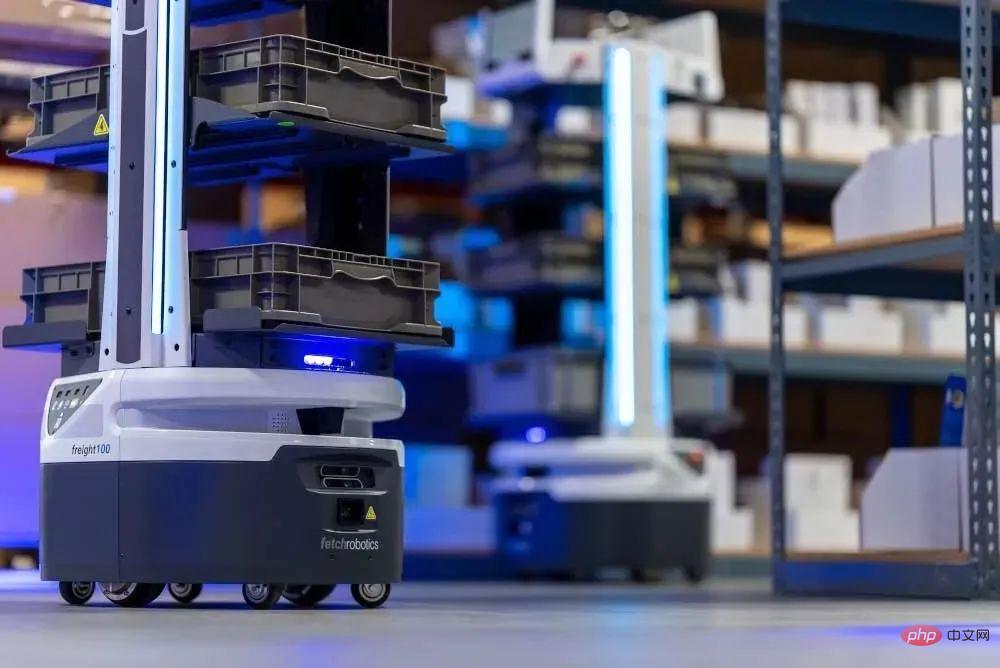Home >Technology peripherals >AI >How can machine vision and deep learning improve logistics and warehousing operations?
How can machine vision and deep learning improve logistics and warehousing operations?
- WBOYWBOYWBOYWBOYWBOYWBOYWBOYWBOYWBOYWBOYWBOYWBOYWBforward
- 2023-04-09 10:31:031291browse
According to the 2021 Pitney Bowes Package Shipping Index, 131 billion packages were shipped globally in 2020. This number is expected to more than double by 2026, accelerated by the global pandemic and the growing e-commerce industry. As online retail purchases increase, the need to automate logistics, warehouse and shipping processes has become a priority.

Packaging measurement, quality inspection, barcode reading, optical character recognition/optical character verification (OCR/OCV) and material handling optimization (currently many Enterprises perform this manually) is a critical stage in achieving automation in the transportation industry value chain.
"Logistics, warehousing and transportation companies are trying to speed up their operations. But speed means precision and accuracy are essential because there is no time to deal with errors. In addition Staffing issues." said Mark Wheeler, director of supply chain solutions at Zebra Technologies. "When you put those three things together, what you get is a very open market by combining existing technologies with new ones in innovative ways. technology to try new things." Most of these innovations are centered around machine vision.
Vision-guided robot
In a warehouse or distribution center, pallets of goods often mark the beginning and end of the warehousing process. Upon entering the facility, palletized shipments are either broken down into individual boxes or stored as complete pallets. Depalletizing applications have transitioned from primarily using humans to relying on vision-guided robots. As the robot places the previous item on the conveyor belt, machine vision speeds up the process by locating the next package to pick.
"Most packages arrive and leave warehouses in pallet loads," says Garrett Place, Robotics Business Development at ifm AG. "They are in modern warehouses. The journey is at the core of most machine vision applications in logistics.
Ben Carey, senior manager of logistics vision products at Cognex, agrees that the application of machine vision in logistics covers Four areas: Measurement, Inspection, Guidance and Identification. Each of these areas is present from the incoming goods receiving process through sorting all the way to the outgoing inspection point.
Ask a machine vision solution developer about the best way to bring repeatability into a use case, and they'll likely say something about limiting the number of variables. After all, variables create applications at the edge. However, most warehousing and logistics operations Moving packages may be of any color, size, shape and material. This level of variability makes technology selection and the creation of solutions extremely difficult.
"Amazon over the past few years The Robot Sorting Challenge is a good example," Place said. "This is the main reason why most machine vision use cases in logistics are multi-camera and multi-modal. One camera and one technology are not enough to manage the variability in these types of applications. "
Zivid Company product marketing manager John Leonard agrees, "Main applications include depalletizing and palletizing boxes in and out of facilities. In between these incoming and outgoing operations are primarily piece picking operations and order picking to fulfill orders. These are all done using different methods, which vary from place to place. "
These methods include autonomous mobile robots (AMRs) guided by onboard 3D vision. For example, AMRs can autonomously walk up warehouse walls to find and select items. Robots can also pick items made by Items delivered by conveyor belt. Other mobile robots can transport items to the vision station to check the type and quantity of goods.

The FlexShelf Guide launched by Zebra Company is the silo size and spacing provide flexible configurations, expanding the types of items that can be picked using AMR.
For full pallet load storage, many warehouses deploy automated guided vehicles (AGVs) for picking and storage Pallets for retrieval. During travel, the AGV relies on machine vision for pallet posture and obstacle detection. Machine vision code reading tracks pallets and box loads throughout the process.
When When fully loaded pallets are ready to leave the facility, AGVs manage the movement while robotic arms convert the boxes into fully loaded pallets. These ready-to-use pallets are then weighed and measured before going into trucks, making pallet dimensions an important part of machine vision in logistics Another powerful use case for.
"The industry has shifted from assessing shipping rates strictly by weight to charging by dimensional weight, making precise dimensional measurements more important than ever important. Daniel Howe, regional development manager for the Americas at LMI Technologies, said, "Smart 3D sensors are a key driver in automating packaging and logistics processes, including volumetric dimensioning, sorting and surface defect detection. "
Many AMRs and AGVs use ifm’s O3R platform for robot sensing. It consists of a compact camera (VGA camera and time-of-flight sensor) and a Vision Processing Unit (VPU) with NVIDIA Jetson TX2 to evaluate the data. Up to 6 cameras can be connected to Linux-based devices, including sensors from other companies.
High demand for increased speed and throughput
While logistics and warehousing applications face many challenges, the need for higher speed and higher Throughput requirements are constant. Challenges include items packaged in clear poly bags, which pose imaging challenges due to the way they reflect light. Other picking operations may require color as part of the item detection process, which may require 3D vision that supports color information in images.
According to Leonard, calibration is a challenge for all 3D cameras because they are designed to operate in the micrometer range, knocks, temperature fluctuations and vibrations common in industrial environments. It is easy to affect the calibration and thus the accuracy of the 3D camera.
Some cameras, such as the Zivid 3D camera, are designed and manufactured specifically to operate in industrial environments, are rated IP65, and feature automatic calibration. This means that if the temperature changes by 5 degrees due to the opening and closing of a large roller shutter door (which is common in logistics warehouses), then the camera will adjust to stay perfectly calibrated.
LMI Corporation has developed the ultra-wide field of view Gocator 2490 sensor, which is specifically designed to provide fast and accurate package size measurements for shipping. Boxes can move on the conveyor at a speed of 2 m/s. According to Howe, a single wide-field Gocator 2490 smart sensor can scan and measure the entire box dimensions (width x height x depth) at 800 Hz, with a scan area of 1 m x 1 m, in all three dimensions (x, Provides 2.5 mm resolution in Y, Z).
The resolution is high enough so that the Gocator 2490 can not only measure the dimensions of various package sizes, but can even detect subtle defects in the packaging. This online inspection capability allows a pass/fail decision to be triggered when a defective package is detected.
Gocator 2490 also provides the opportunity to address more advanced packaging applications such as gap filling, which involves scanning an open package with items and determining how much packaging material is needed to fill the void space. For such applications, a dual-camera configuration helps avoid occlusion inside a box or tote.
Edge Deep Learning
As the complexity of the logistics field increases exponentially, the application of machine vision is also facing more challenges. For example, trying to detect different types of objects in random orientations on a high-speed conveyor belt, traditional rule-based machine vision inspection will encounter difficulties in these situations.
However, easy-to-use machine learning and deep learning in embedded platforms are emerging to solve previously challenging applications. For example, Cognex's recently launched In-Sight 2800 features edge learning that is easy to set up and requires no programming. It quickly and accurately sorts everything from boxes to suitcases to plastic bags and runs entirely on smart cameras.
"Technologies such as edge learning on the In-Sight 2800 improve package inspection rates, resulting in less manual rework and enable better order accuracy through more advanced material handling automation ," Carey said, "Our customers benefit from increased processing speeds and fewer manual interactions, allowing these companies to manage fluctuating demand without changing headcount, which continues to be a problem in today's labor-stretched environment. Challenge."
Democratization of Machine Vision
For example, most of the technologies deployed in modern warehouses, including 2D and 3D cameras and augmented of computing power, are all iterations of previously known methods. What's somewhat new is leveraging all of these technologies in a multi-camera, multi-modal strategy, combined with the large-scale processing power of ML to manage applications.
"We used to see single-vendor solutions in warehouses," Place explained. "Now, we see a combination of multiple vendors and technologies, each Each vendor and technology has its own strengths and is deployed together to solve challenges. This approach will continue to unlock use cases previously untouched by machine vision. Think of it as the democratization of machine vision in warehousing and logistics."
It is difficult to focus on the progress of a technology. Sure, industrial cameras are delivering better, more repeatable data and calculations are faster, but nothing is game-changing. The biggest advancement is in the ease of use of components in a multi-technology approach to solving warehouse problems.
"Logistics is moving in the direction of robotics," Place concluded. "Robotics is an integration problem. Machine vision and its complexity are moving away from a single camera focus to reduce modern All components required for a warehouse are integrated into the focus of friction. This approach will take us to the next step in this journey."
The above is the detailed content of How can machine vision and deep learning improve logistics and warehousing operations?. For more information, please follow other related articles on the PHP Chinese website!
Related articles
See more- Technology trends to watch in 2023
- How Artificial Intelligence is Bringing New Everyday Work to Data Center Teams
- Can artificial intelligence or automation solve the problem of low energy efficiency in buildings?
- OpenAI co-founder interviewed by Huang Renxun: GPT-4's reasoning capabilities have not yet reached expectations
- Microsoft's Bing surpasses Google in search traffic thanks to OpenAI technology

